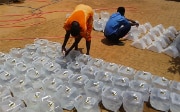Jordan, Syria, and Lebanon are highly vulnerable to earthquakes, floods, droughts and desertification. Earthquakes are a major threat to the region, as most of these countries’ populations lives within 50 km of the seismically active Dead Sea Transform Fault. The location of rapidly growing cities like Amman, Aqaba, Damascus and Beirut in earthquake-prone areas drastically increases vulnerability in terms of the number of people and infrastructures exposed to hazard. National and local capacities for disaster risk reduction vary considerably between countries at all levels. In 2001, an agreement was signed between Jordan and Switzerland regarding cooperation in Disaster Relief and Preparedness.
Disaster risk reduction, emergency relief and reconstruction
Objectives of the DRR projects
The overall goal of the SDC programme for Disaster Risk Reduction (DRR) is a contribution to ensure safe life and sustainable livelihood by minimizing the effects of natural disasters. The programme supports the implementation of the Hyogo Framework for Action in the Middle East and local disaster-prevention institutions at regional, national and local levels by way of:
- Empowerment through capacity building to prepare national and local operational teams for efficient crisis management and equip them with operational resources.
- Public awareness and education by various campaigns and informational events to inform local populations of natural hazards and how to act before, during and after disasters.
- Policy dialogue on disaster risk by promoting exchanges with government decision makers about the importance of prevention and preparedness.
- Regional knowledge sharing on disaster risk reduction to establish an active regional mechanism for knowledge and expertise exchange among groups in Jordan, Syria and Lebanon.
In addition, the Message concerning the increase of the Confederation’s Official Development Assistance (ODA) proposes an increase in the current budget for the Swiss Agency for Development and Cooperation (SDC), for Switzerland to make a greater contribution to alleviating poverty, to securing water supplies and to adaptation to climate change in developing countries.
The SDC wishes to achieve the following results with the additional funding:
- Sustainable water management – both national and cross-border – will be improved still further in major catchment areas, and instruments will be deployed in the water sector in the interests of better global governance.
- Access to clean drinking water and basic sanitation facilities will increase in rural areas and small towns.
- The efficiency of family farms will be improved.
The Swiss Cooperation Programme’s contribution to DRR is aligned with the Sendai Framework for Disaster Risk Reduction 2015-2030 adopted by the UN World Conference in March 2015 as well as by the interventions carried out under the previous Cooperation Strategy. When planning and implementing projects, the domains of intervention take into account disaster risks and foster an enabling environment for integrated risk management at the national and sub-national levels.

Emergency relief means saving lives, alleviating suffering, and ensuring survival. Damage is repaired as rapidly as possible, and additional emergency measures are taken to help the victims survive. The next step is to re-establish basic supplies and services and to support the afflicted population in the task of reconstruction.
